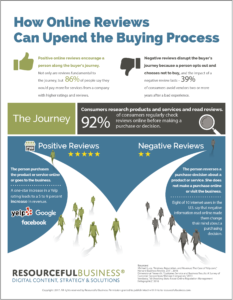
Data Studio Connectors: 4 Easy Steps to More Insightful Analytics
October 28, 2017
The Essential Customer You May Not Be Reaching
January 8, 201840,000 every second,
3.5 billion each day,
1.2 trillion per year.
According to Internet Live Stats, these figures reflect the number of online searches being processed by Google. For today’s business owner, the sheer number of search queries underpins the critical importance of a company’s online reputation because customers in search of product information begin online.
Most business owners know the concept of the buyer’s journey. Typically, it is thought of as a three-step process that includes awareness, consideration, and decision. But, what if the digital age has ushered in a new buyer’s journey–one with four steps. One step behaves as a gatekeeper to the final decision, and the traditional journey may never get to the last step because the buyer chooses not to go through the gate.
In fact, online reviews might just be that gatekeeper. In an article by the Moz team, they found that four or more negative articles about a company or product appearing in Google search results could make a company lose 70% of potential customers. That’s a lot of customers.
The new buyer’s journey
The growth of the internet is propelling online search, and rich snippet review stars below the business name are the first item potential customers check when skimming the Search Engine Result Pages (SERP). Any business that displays three stars or less is often ignored.

In this new digital scenario, the buyer’s journey is a four-step process:
STEP ONE: Awareness – I have a problem.
It could be a minor issue–you’re thirsty–or a more serious one such as you are injured and need to see a doctor.
STEP TWO: Consideration – I think about options to solve my problem.
If you’re the thirsty person above, you might consider whether you should visit the neighborhood coffee shop, or do you swing by the local convenience store and pick up a cold drink on the go? Let’s say you choose the coffee route. You instinctively think about all kinds of parameters:
- How much time do I have?
- Is there a parking lot or do I need quarters for the meter?
- Do I need cash or can I use my coffee shop loyalty card?
- Do I really want to pay for a latte, or shall I just use my single serve coffee maker at home?
- Where is the closest coffee shop?
- Is the place popular? Do people like going there and will it be crowded?
STEP THREE: Search – I do an online search and compare my options
You Google, “Where is the best coffee in [your town]?” A SERP gives you a list of alternatives even populating the top of the page with coffee shops that are geographically closest to you. You skim down the page, and your eye is drawn to the rich snippet stars.
You’ve arrived at the new gatekeeper in the buyer’s journey–online reviews. You filter out any businesses with three or fewer stars and never click the search result to learn more about the business or visit their website. They’re out.
STEP FOUR: Decision – I fix my problem.
You have time, a few dollars in your pocket and you want the fancy latte. You go out the door and visit the local coffee shop, which by the way, had 5-stars below their name in the search engine results. You never knew that the coffee place around the corner had a special on pumpkin spice lattes (your favorite) because they had 3-stars below their name, and you never clicked through to the website.
Four or more negative articles about a company or product appearing in Google search results could make a company lose 70% of potential customers. –Moz
Online reviews
In the digital age, the buyer’s journey looks different than the traditional model.
Online reviews can upend the buyer’s journey completely, and although some would argue that perusing online reviews could be lumped into the traditional Consideration phase, maybe they shouldn’t be. Why? Because checking online reviews is no longer an action people do occasionally. It has become a fundamental step in the buying process, and with just a glance, can dissuade potential customers from buying your product, service or even bothering to contact you.
Reputation management is now a necessity
No matter the size of your organization, an online review management strategy is no longer nice-to-have, but a must-have. Reputation management technology can help, but at the very least and even if it’s a manual process, ensure that your management team monitors, responds to and actively engages with customers that are writing online reviews about your company.
Good reviews are “social proof” that your business is worth visiting, your product or service worth buying. Negative reviews end the buyer’s journey that should be bringing customers to your door.






1 Comment
Great informative article. Thanks!